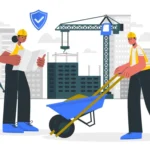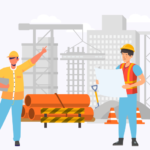Whether your workforce consists of nurses conducting house visits, utility staff working in isolated areas, or truck drivers covering long distances, lone work poses significant risks. However, high-risk situations don’t have to equate to unsafe conditions. By implementing practical precautions and addressing potential risks, your business can actively contribute to the safety of lone, isolated, and mobile workers.
Employees should have a comprehensive understanding of the risks associated with their roles. As a manager, you must provide them with specific training on how to ensure safety in their particular job settings.
- In 2021, job-related fatalities accounted for about 5190
- The most dangerous occupations include logging, roofing, truck driving, and construction work.
- Approximately 13 people are expected to succumb to fatal injuries sustained at work today.
Why is Safety Management Necessary?
The repercussions of an unsafe work environment go beyond the fatalities. These may include:
Legal Consequences: Companies may face legal actions, fines, or lawsuits for negligence in ensuring the safety of their lone workers.
Reputation Damage: Such incidents can tarnish the company’s reputation, leading to a loss of trust among clients, partners, and the public.
Financial Impact: Compensation, legal fees, and increased insurance premiums can result in significant financial losses for the business.
Employee Morale: Workplace safety concerns can negatively impact the morale and well-being of other employees, affecting overall team dynamics.
Operational Disruption: Fatalities or accidents can disrupt normal operations, leading to delays, decreased productivity, and potential loss of business.
However, with simple yet effective measures you can ensure employee well-being. This blog will explore 8 crucial lone worker safety management tips for field business managers that will help avert the above challenges.
Important Tips for Lone Worker Safety Management
Train employees to respond to critical situations
As lone workers, they must be prepared to take the first action in the face of a dangerous situation. They should possess practical knowledge of first aid to address injuries or accidents effectively.
Additionally, employees should acquire skills in risk defusing, enabling them to de-escalate situations before they intensify.
Conduct Regular Safety Management Checks
Conduct regular checks in all your worksites to identify potential safety issues. If the work involves using machinery, conduct safety checks to ensure everything is in proper working order.
While working alone, lone workers may recognize issues that others might otherwise go unnoticed. This is particularly crucial when dealing with heavy machinery or operating in high-risk industrial settings.
For example, working in an area with poor ventilation and significant gas emissions poses serious risks. If they spot a safety hazard, have a communication system in place for them to notify this issue.
Safety equipment
Being prepared also involves having the appropriate tools, including communication devices, first aid supplies, shelter, fire-retardant materials, extra fuel, spare tires, and provisions like food and water.
The unpredictable nature of emergencies makes it essential to consider the potential duration before help arrives. Taking the time to plan for necessary provisions could be a life-saving measure.
Monitor The Lone Workers
Information is a powerful tool, and being aware of your employees’ locations and well-being can be crucial in crises. Supervise and guarantee the safety of employees during fieldwork by implementing monitoring measures.
This can be made easy with a GPS-enabled lone worker safety app. Workers have the option to manually activate a safety alarm through the app.
Track their movements
It’s essential to maintain a transparent record of your employees’ whereabouts while they are in the field. Having information on their recent locations becomes critical in situations where immediate assistance is needed.
Field employee management apps provide comprehensive breadcrumb reports for you to track employee movement. This report provides the location trails of employees within the specified date range. Additionally, the location trails can be visualized in a map view.
Conduct regular check-ins
For lone workers exposed to higher risks, such as those operating in hazardous areas, increased monitoring is paramount. These employees should receive special attention, ensuring constant awareness of their location and status, with regular check-ins as a standard procedure for all field employees.
You can also create a customized safety-check workflow to identify and address potential threats. Most systems support multi-level back-office threat escalation through IVR, SMS, and email. You can also send reminder notifications within the app for employees to check in and mark their safety.
Real-time Status
Modern safety apps for lone workers offer automation for this process. Before entering a potentially risky situation, a lone worker can make a GPS-tagged check-in via the app.
You can receive real-time details on employee and phone status, including ‘location,’ ‘last activity,’ ‘battery level,’ and additional information. Any selected status information and events can be configured to activate alerts.
Silent Signaling for Help
Certain situations may necessitate the discrete signaling of distress, especially when overt attempts to contact help might escalate the danger. Duress codes, panic buttons, and personal safety devices offer a silent means of signaling for help without aggravating potential attackers further.
allGeo allows an employee facing distress to activate the SOS alarm by either pressing the dedicated SOS button on the app or quickly tapping the phone’s ‘power’ button four times.
Conclusion
A workplace free from risks is essential for the success of a company. It contributes to goal attainment and enhancing the overall efficiency of both management and employees.
Safety management with the right technology, coupled with proper precautions, can instill a sense of safety in lone workers. This enables them to perform their duties with the assurance that assistance is readily available, and compliance with labor safety regulations.
Beyond regulatory adherence, investing in lone worker safety cultivates high employee morale, boosting overall job satisfaction and performance. The benefits of a safe workplace, aided by employee safety apps, contributes to long-term benefits.


